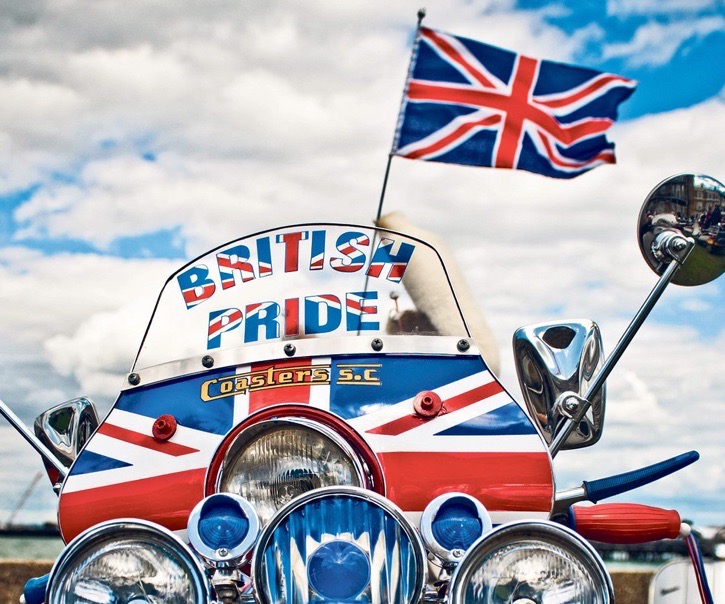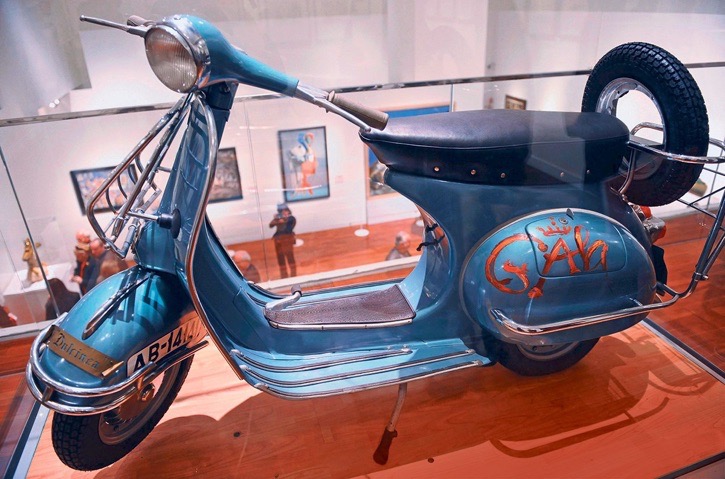Piaggio bits 'n pieces. I'm wondering gn2, did you know All of this? I'm thinking Yes

(Below was taken from Motorcycle News Online - 2016
70 years of Vespa:
10 things you didn't know
Published: 02 September 2016
1 of 4
To this day a scooter is about the easiest, cheapest, and most convenient mode of powered transport there is, certainly for town riding. You can nip through the tightest of gaps in traffic, park them in the smallest of spaces, they’re mega efficient on fuel, boast decent storage space so you can leave your helmet with the bike, they’re clean (because the Vespa bodywork encloses all the dirty stuff) and they’re the easiest things in the world to ride; no gears, no clutch, just twist and go. Oh, and they’re fun, too.
This year marks the 70th anniversary of the first Vespa 98cc rolling off the production line – and here are 10 more things you should know about the world’s most famous scooter brand.
What does Vespa mean?
It’s Italian for ‘wasp.’ Enrico Piaggio (the son of the founder of Piaggio, which owns Vespa) came up with the name after first seeing the MP6 prototype for the first time. He thought the wide back end, joined to the front end by a narrow waist, looked like the body of a wasp, with the steering column resembling antennae.
When did Vespas become cool?
Although Vespa were selling 60,000 scooters a year by 1950, they only really started being viewed as cool in 1953 when Gregory Peck and Audrey Hepburn zipped around on a Vespa in Roman Holiday. The movie led to 100,000 units being sold the following year and when James Dean, John Wayne, Marlon Brando and Charlton Heston were pictured on Vespas, there was no turning back.
How different are modern Vespas to classics?
The biggest change in modern Vespas is that they all use four-stroke engines now so the classic sound and smell has been lost. Engine capacity has also grown in many modern models (at 300cc, the latest GTS is twice the size of the 1960 GT150) and it goes without saying that modern brakes and suspension components are far superior to those used in the early years. The latest GTS even has ABS! But the one constant is the styling – modern Vespas retain a respect for their heritage and all bear a family resemblance that’s totally distinct to the brand.
Who designed the Vespa?
It’s all down to former aeronautical engineer Corradino D’Ascanio who found motorcycles dirty, uncomfortable and bulky. He also found it hard to change wheels on them after a puncture. He solved all of these problems with his design for Vespa, using direct mesh to negate the need for a chain, enclosed bodywork to keep riders away from working parts (as well as providing weather protection), and even designing a supporting arm instead of front forks to make wheel changes easier.
Where are Vespas made?
The factory is at Pontedera, near Pisa in Northern Italy, and it’s more like a small town than a scooter factory. Seven brands of two-wheelers are made there, all owned by Piaggio. As well as Vespa, these include Piaggio, Aprilia, Scarabeo, Derbi, Gilera, and Moto Guzzi. In 2014 alone, Pontedera churned out almost half-a-million bikes and scooters. The facility includes a test track and even a direct railway link. All Vespas sold in the European market are made at Pontedera while models for the Asian market are made in Vietnam and the Baramati plant in India.
Why should I buy a Vespa and not a far cheaper scooter from the Far East?
Cheap scooters from the Far East may do a similar job to more expensive machines but they have none of the class, style, or heritage of a Vespa. When you buy a Vespa, you’re also buying into the brand and lifestyle in the same way that Harley-Davidson and Ducati owners do.
There are plenty of brilliant, fast and reliable Japanese scooters but they can never hope to offer 70 years of brand-defining cool and heritage. You simply cannot manufacture that.
How many different models of Vespa are there?
There have been 34 different versions since 1946. Today there are five model lines – the classic PX with manual-transmission, and the more modern twist ’n’go S, LX, GT and GTS ranges.
Is the UK a big market for Vespas?
Outside of Italy, the UK is the biggest market for Vespa and at the height of the Mod sub-culture in the 1960s – as immortalised in the Who’s Quadrophenia – the UK was the biggest market in the world for the Italian manufacturer.

- image.jpeg (166.8 KiB) Viewed 3130 times
Is there a big difference between Vespa owners and Lambretta owners?
Even during the height of the Mod movement in the 1960s, both makes were considered equally cool. Some prefer Lambrettas because their engines are centrally situated (whereas the Vespa engine is on the right-hand side of the bike) so they feel they handle better, but Vespas have a reputation for being more reliable. It’s more a case of friendly banter between owners, rather than rivalry. Lambretta closed shop in 1972 and, although production continued in India under the SIL name, production ceased in 1997. SIL now makes three-wheeler Vikrams powered by Lambretta engines as well as spares for certain Lambretta two-wheeled models.
What’s the most famous Vespa in the world?
Probably the 1962 150S that was modified by surrealist artist Salvador Dali. The bike belonged to a student but Dali painted it up with the name of his muse and partner, Gala, and added his own very distinct signature. It’s on display in the Vespa museum in Pontedera and is considered to be the most valuable Vespa in the world.

- image.jpeg (133.53 KiB) Viewed 3130 times
By Stuart Barker


